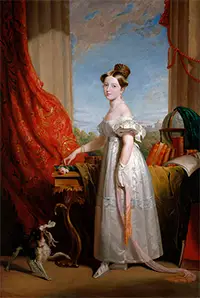Queen Victoria of the United Kingdom
Part 1: Heir apparent Queen Victoria was one of the most well-known monarchs of the United Kingdom, serving on the throne for 63 years, through periods of momentous change, both in her own country and in the world. She was born on May 24, 1819. Her father was Edward, Duke of Kent, whose father was King George III. Victoria's mother was Princess Victoria of Saxe-Coburg-Saalfeld. The child's birth name was Alexandrina Victoria, but she was from a very young age known as Victoria. 
She was famous in later life for her height. She was 4 feet 11 inches tall. A passionate student of the arts, she enjoyed painting and drawing and was fond of writing in her journal. The young Victoria grew up in a very structured and cloistered environment, learning the strict rules and ways of the Kensington System, named after the palace in London in which Victoria stayed with her mother. Engineered by Princess Victoria and her attendant, Sir John Conroy, the Kensington System kept young Victoria as close as possible to her mother at all times, sheltering her from the outside world. She had only two playmates during her entire growing-up years. One was her half-sister, Princess Feodora of Leiningen; the other was Victoire, the daughter of Conroy. Chafing under the harsh, strict routine, the young Victoria grew to despise her mother and her restrictions. Educated by a governess, she did learn, however, mastering English, French, German, Italian, and Latin. Victoria's grandfather, George III, died in 1820 and was succeeded by his oldest son, who became King George IV. This George had been effectively in charge of the government for a decade already by the time he took the throne, because of his father's increasing mental illness, and he served another decade ruling by himself. George IV died in 1830 and his brother became William IV. When William died after only seven years on the throne, his heir apparent was Victoria. She became Queen Victoria of Great Britain on June 20, 1837. She was not, as had been every monarch before her since 1714, the ruler of Hanover, in Germany. King George I had been the ruler of Hanover when he became King of England. The following five monarchs had been male and so had ruled Hanover without having to confront the German law that forbade a female succession to the throne. Victoria did not become the Hanoverian ruler; taking that position was her uncle, the Duke of Cumberland, who became King of Hanover. Next page > Long-reigning monarch > Page 1 2, 3 |
|
Social Studies for Kids
copyright 2002–2024
David White




